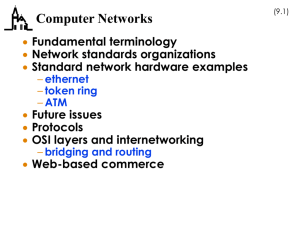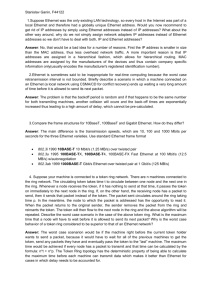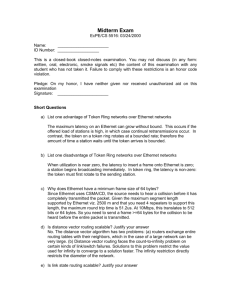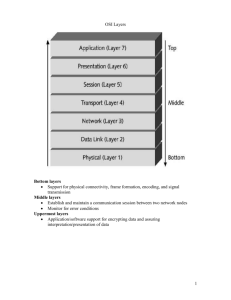EE 122 1st Term Exam
advertisement
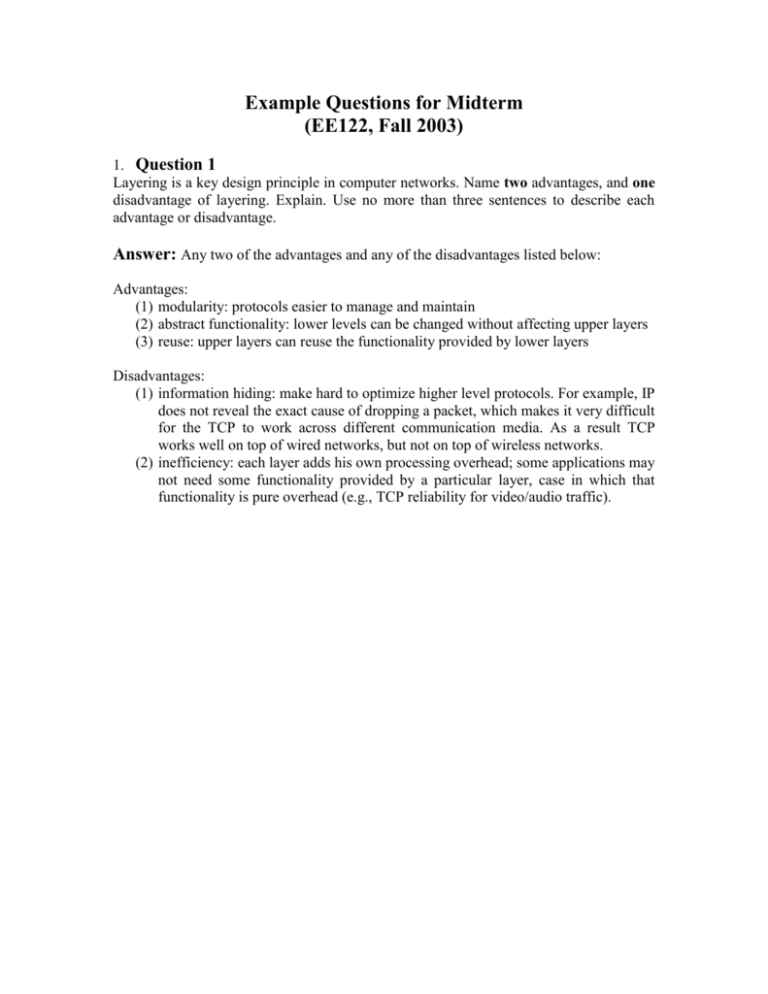
Example Questions for Midterm (EE122, Fall 2003) 1. Question 1 Layering is a key design principle in computer networks. Name two advantages, and one disadvantage of layering. Explain. Use no more than three sentences to describe each advantage or disadvantage. Answer: Any two of the advantages and any of the disadvantages listed below: Advantages: (1) modularity: protocols easier to manage and maintain (2) abstract functionality: lower levels can be changed without affecting upper layers (3) reuse: upper layers can reuse the functionality provided by lower layers Disadvantages: (1) information hiding: make hard to optimize higher level protocols. For example, IP does not reveal the exact cause of dropping a packet, which makes it very difficult for the TCP to work across different communication media. As a result TCP works well on top of wired networks, but not on top of wireless networks. (2) inefficiency: each layer adds his own processing overhead; some applications may not need some functionality provided by a particular layer, case in which that functionality is pure overhead (e.g., TCP reliability for video/audio traffic). 2. Question 2 Let l=1000 bit be the minimum size of an Ethernet packet. Let c=2*108 m/sec be the speed of light in the Ethernet cable. The Ethernet has a bandwidth of 10 Mbps. What is the maximum distance d between two end-hosts on an Ethernet cable? Justify your answer. (Hint: To justify your answer you may want to derive the relationship between the minimum packet size l and the maximum distance d between two end-hosts.) Answer: Suppose hosts A and B are at the opposite ends of the Ethernet segment, and that host A sends a packet of minim size l to B at time t. Host B receives A’s packet at time t+d. Suppose that just before it receives the packet, host B sends its own packet. This packet reaches A at time t+2d. At this point A should still be in the process of sending the packet; otherwise it will not be able to detect the collision. Thus, the transmission time of the packet, l/B, should be such that l/B = 2*d, where B is the Ethernet bandwidth. Let L be the distance between A and B. Then, we have l/B = 2*L/c L = l*c/(2*B) = 103*2*108/(2*107) = 10,000 m 3. Question 3 Token ring is an alternative to Ethernet to arbitrate the access to a shared medium. With token ring, a special packet (called “token”) is circulated in the clock-wise direction around a ring to which N hosts are connected. When it receives the token, a node can send one packet, if it has any packets to send. After it sends the packet, the node passes the token to the next node on the circle. If it doesn’t have any packets to send, the node passes the token immediately to the next node. Consider the following scenario based on the figure below. Initially, A has the token and has a packet to send. Thus, A sends its packet and then passes the token to B. Suppose B has several packets to send when it receives the token. B sends only one of its packets and then passes the token to C. Suppose C does not have any packet to send, when it receives the token. As a result, C passes the token immediately to D. If D has at least a packet to send when it receives the token, D sends one packet and passes the token to A. This process repeats indefinitely. Suppose the propagation delay along the ring is d, and that the time to process the token is negligible. Thus, when no node has packets to send, it takes the token time d to make a complete round. Let n be the number of hosts connected to the ring that have packets to send, let C be the link capacity, and let l be the packet size (assume all packets have the same size). What is the utilization of the token ring? (Note: Define the utilization as the ratio between the maximum total number of bits that were sent by all hosts during one round and the total number of bits that can be carried by the ring during one round, i.e., C*tround, where tround is the time it takes the token to complete a round). A D B Answer: According to the note, we have utilization = n*l/C*tround C The time it takes to transmit a packet is l/C. Thus, when all n hosts have packets to send: tround = d + n*(l/C), utilization = (n*l)/(C*d + n*l) 4. Question 4 (20 pt) Consider the network below. Assume that the network implements the Distance Vector routing protocol. (a) (5 pt) Write down the routing table of each node. (b) (15 pt) Assume the cost of the link between nodes A and C decreases from 7 to 1. Write down the routing table of each node at every step until routing tables converge. Assume that both A and C see that the change of the link (A, C)’s cost at the same time, and that exchanges of routing information and routing table updates are synchronous (i.e., they happen at the same time at all nodes) 2 A B 2 3 7 D 1 C Answer: (a) See first column; (b) see the last three columns. Link costs that change during each iteration are in red. DA B C B 2 10 C 5 7 D 4 8 DA B B 2 C 5 D 4 C 4 1 2 DA B B 2 C 5 D 4 C 4 1 2 DB A A 2 C 7 D 6 DB A A 2 C 7 D 6 C 8 6 3 3 4 2 DB A A 2 C 3 D 6 C 4 3 4 DC A B D A 1 5 5 DC A A 1 B 3 D 5 B 5 3 5 DD B A 4 B 2 C 5 C 2 4 1 C 8 6 3 3 4 2 DC A B A 7 5 B 9 3 D 11 5 D 5 3 1 B 3 3 3 DA B B 2 C 5 D 4 C 4 1 2 D 6 3 2 DB A A 2 C 3 D 4 C 4 4 3 4 4 2 D 5 3 1 DC A A 1 B 3 D 3 B 5 3 5 DD B A 4 B 2 C 5 C 2 4 1 D 5 5 1 DD B A 4 B 2 C 5 C 6 4 1 DD B A 4 B 2 C 5 C 6 4 1 d(A,C)=d(C,A)=1 D 3 3 1
